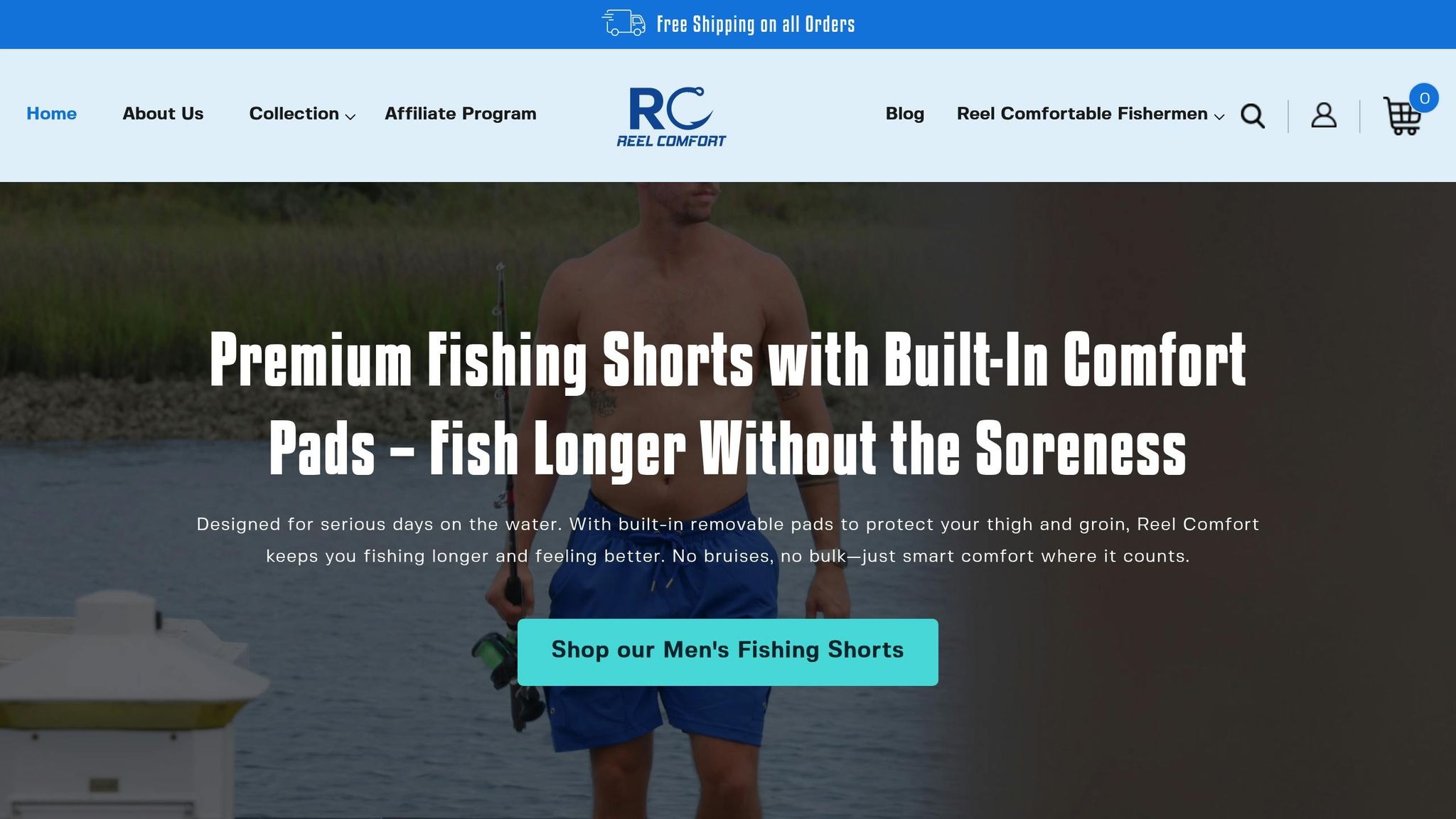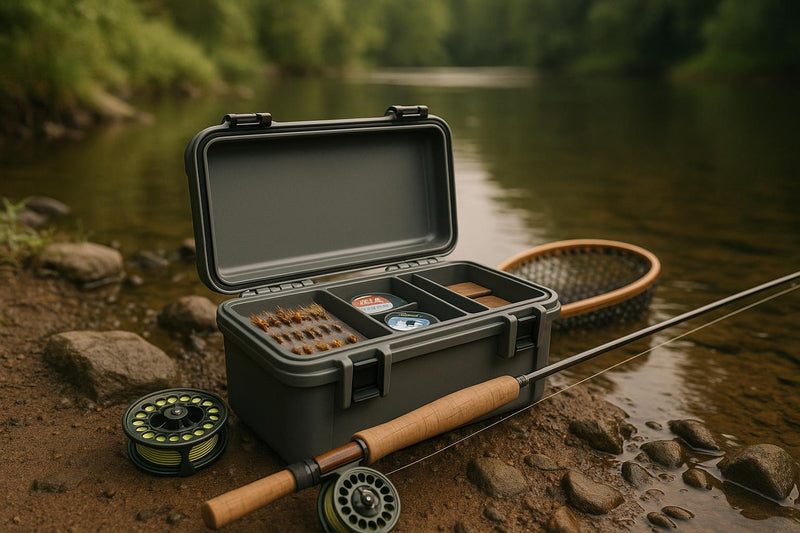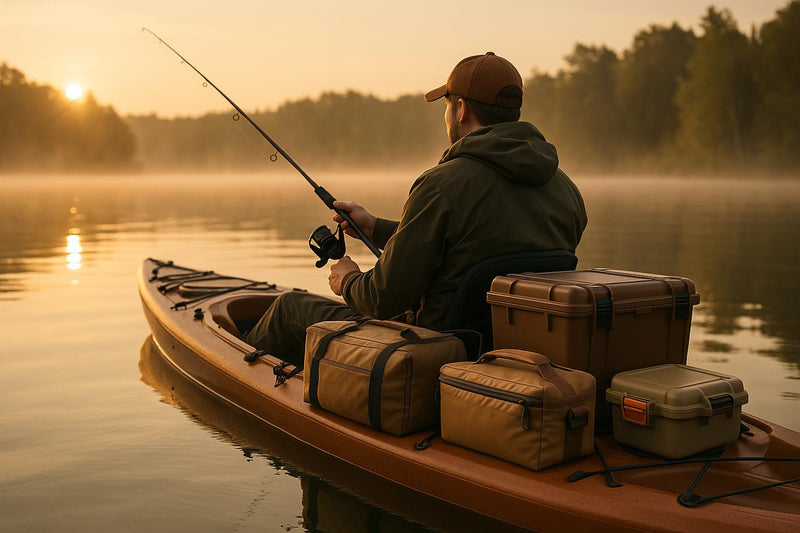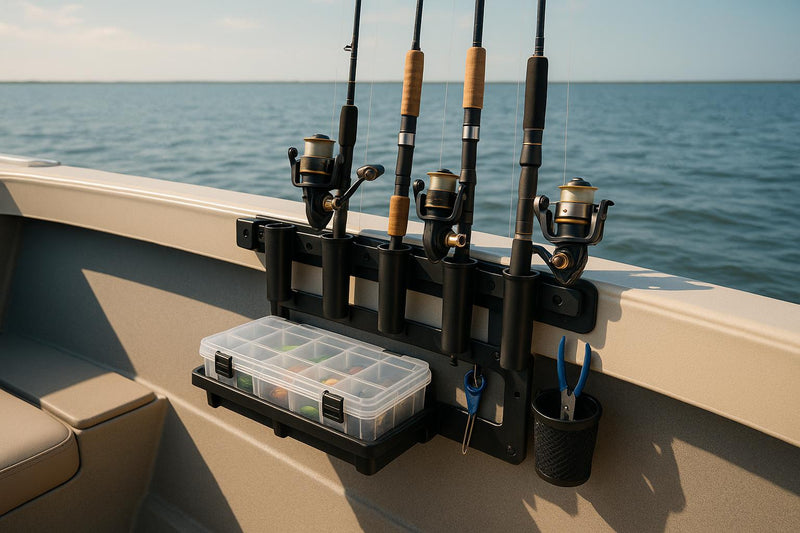The fishing apparel industry is shifting toward biodegradable fabrics to address plastic pollution and waste concerns. These materials, made from organic sources like hemp, cotton, and bio-based polymers, decompose naturally, reducing long-term waste. Compared to synthetic and recycled synthetics, biodegradable fabrics offer eco-friendly benefits but come with trade-offs in durability, cost, and performance. Here's a quick breakdown:
- Biodegradable Fabrics: Reduce waste, decompose naturally, and use fewer resources in production. However, they cost more and may wear out faster under heavy use.
- Conventional Synthetics: Durable, affordable, and quick-drying but contribute to pollution and microplastic waste.
- Recycled Synthetics: Repurpose waste like fishing nets and plastic bottles into high-performance gear, balancing durability and reduced environmental impact.
Reel Comfort, a fishing gear brand, is exploring biodegradable fabrics for their $59.99 fishing shorts without compromising key features like moisture-wicking, UV protection, and durability. This shift reflects growing demand for eco-conscious fishing gear that performs well while reducing harm to waterways.
1. Biodegradable Fabrics in Fishing Shorts
Biodegradable fabrics are changing the game in fishing apparel by offering materials that naturally break down at the end of their life. These fabrics are made from organic sources like hemp, organic cotton, linen, and cutting-edge bio-based polymers derived from plants such as corn and sugarcane.
Impact on Nature
One of the biggest advantages of biodegradable fabrics is their ability to reduce waste and lessen the environmental impact of fishing gear. Unlike synthetic materials that can linger in landfills for decades, these fabrics decompose naturally when composted under the right conditions.
At the end of their use, biodegradable fishing shorts break down into organic compounds that can enrich the soil. Additionally, their production often results in fewer greenhouse gas emissions compared to traditional petroleum-based synthetics. For example, hemp-based fabrics typically use much less water than conventional cotton and even contribute to soil health due to their natural resistance to pests.
Durability and Performance
Thanks to advancements in fabric processing, biodegradable materials now offer impressive strength and performance. Hemp blends, for instance, are as strong as many synthetic fabrics and come with natural moisture-wicking properties that are crucial for long fishing trips.
These fabrics are also highly breathable, keeping anglers comfortable by allowing air to circulate while offering protection from UV rays and wind. On top of that, many biodegradable options have natural antimicrobial properties, helping to reduce odors during extended outings.
That said, durability can be a concern for heavy-duty use. While biodegradable fabrics hold up well for most fishing activities, they may wear out faster than synthetics when exposed to constant abrasion from boat surfaces or rocky shores. Choosing these materials often means balancing eco-friendliness with the need for long-term durability, depending on your fishing habits.
Cost and Affordability
Currently, biodegradable fabrics come with a higher price tag due to smaller production scales and the specialized processes needed to maintain their eco-friendly properties. Men's fishing shorts made from these materials are generally more expensive than their synthetic counterparts.
This higher cost reflects the complexity of the supply chain and the extra care required to produce biodegradable textiles. Limited production further drives up prices.
However, the initial investment might even out over time when you factor in the environmental benefits and the quality of well-made biodegradable garments. As production methods improve and scale up, prices are expected to become more competitive with traditional options.
Comfort and Practicality for Anglers
Biodegradable fabrics bring a level of comfort that many anglers appreciate. Their natural fibers excel at regulating temperature, keeping you cool during hot summer days and comfortable on those chilly early-morning outings.
These materials also have a soft, smooth texture that avoids the scratchiness often associated with some synthetic fabrics. Their natural moisture-wicking properties help prevent the clammy feeling that can come with certain synthetic options.
While drying times for these fabrics are a bit longer than those of advanced synthetic quick-dry materials, this is a minor inconvenience in warm, breezy conditions. Hemp and organic cotton blends also offer a natural stretch, providing plenty of mobility for casting lines or navigating a boat.
Caring for biodegradable fishing shorts is simple. Most can be washed with standard laundry procedures, but it’s best to avoid harsh detergents and high heat to preserve the integrity of the natural fibers and extend their lifespan.
2. Conventional Synthetic Fabrics in Fishing Shorts
When it comes to fishing shorts, materials like polyester, nylon, and polyamide have been industry favorites for years. These synthetic fabrics, derived from petroleum, are designed to meet the demands of anglers, focusing on durability and performance rather than environmental considerations.
Impact on Nature
The environmental cost of using traditional synthetic fabrics is hard to ignore. Because they're made from non-renewable fossil fuels, their production significantly contributes to greenhouse gas emissions. On top of that, washing these materials releases microfibers into waterways, which can harm aquatic ecosystems. Their durability, while a benefit in use, also means they linger in landfills for decades, adding to pollution concerns.
Durability and Performance
One of the biggest reasons for the popularity of polyester and nylon blends is their ability to endure the wear and tear of fishing activities. Whether it's the abrasion from boat decks, tackle boxes, or rocky shorelines, these fabrics hold up remarkably well. They also maintain their structure through multiple washes, making them a practical choice for anglers.
Another major advantage is their quick-drying nature, which helps prevent chafing during long fishing trips. Many of these fabrics come with built-in UV protection, a must-have for spending hours under the sun. However, it's worth noting that exposure to excessive heat - like leaving them in a hot car or using high-temperature drying - can reduce their elasticity and affect their fit over time.
Cost and Affordability
Synthetic fabrics have the added benefit of being cost-effective. Thanks to established manufacturing processes and large-scale production, these materials remain affordable, making them accessible to anglers of all budgets.
Comfort and Practicality for Anglers
Modern polyester and nylon blends are designed with comfort in mind. They wick moisture away from the skin, dry quickly, and often include four-way stretch for enhanced mobility. Many also feature odor control with regular washing and provide water resistance to handle light rain or ocean spray. For more details on how these technologies work, check out the Reel Comfort blog on quick-dry fabric technology and water-resistant gear.
3. Recycled Synthetic Fabrics in Fishing Shorts
The fishing industry is increasingly turning to recycled synthetic fabrics as a practical compromise between traditional synthetics and fully biodegradable materials. These fabrics transform waste - like discarded fishing nets, plastic bottles, and textile scraps - into high-performance fishing gear. This approach not only tackles waste management issues but also meets the performance demands of anglers. Recycled synthetics combine eco-consciousness with the durability and functionality anglers rely on.
Impact on Nature
Recycled synthetic fabrics help reduce environmental harm by repurposing waste that would otherwise end up in landfills or pollute oceans. For instance, recycled polyester generally requires less energy to produce and results in fewer carbon emissions than virgin polyester. This process also provides a creative way to address ocean pollution, turning ghost fishing nets - abandoned or lost gear that threatens marine life - into functional apparel. This repurposing contributes to cleaner waterways while giving these materials a second life.
That said, recycled synthetics aren't without their challenges. Like all synthetic fabrics, they release microfibers during washing, which can eventually make their way into water systems. Some manufacturers are exploring treatments to reduce this issue, but it remains a concern. Still, recycled fabrics play a role in reducing the need for new plastic production while addressing existing waste problems.
Durability and Performance
Modern recycling techniques ensure that recycled synthetics can perform just as well as virgin materials. These fabrics maintain essential features like quick-drying, UV resistance, and durability against abrasion. For example, recycled polyester derived from plastic bottles retains its strength even after multiple washes, though performance can vary slightly depending on the waste source.
Recycled synthetics also come with a proven track record. Unlike newer biodegradable materials still undergoing extensive testing, recycled polyester and nylon have been used reliably for years. Anglers can trust these fabrics for consistent moisture-wicking, stretch, and weather resistance. For a deeper dive into how these materials work, check out our guide on quick-dry fabric technology.
Cost and Affordability
While recycled synthetics are more expensive to produce than virgin materials due to the additional processing involved, they are still more affordable than many biodegradable alternatives. As recycling methods continue to advance and scale up, these costs are expected to become more competitive with virgin production.
Comfort and Practicality for Anglers
Recycled synthetics offer comfort levels comparable to virgin materials, making them a practical choice for anglers. These fabrics dry quickly after getting wet, resist saltwater damage, and retain their shape over time. They are also easy to care for, making them ideal for extended trips. Additionally, recycled polyester blends resist wrinkles and maintain their structure, ensuring anglers stay comfortable and prepared for multi-day adventures.
This balance of comfort, reliability, and reduced environmental impact makes recycled synthetics a compelling choice for anglers. To explore more about sustainable fishing gear, check out our article on fishing shorts made from recycled nets.
sbb-itb-cb0a783
Advantages and Disadvantages
Selecting the right fabric for fishing shorts involves weighing the pros and cons of each material. These trade-offs directly affect your fishing experience, so understanding them is essential. Here's a breakdown of the benefits and limitations of common fabric types:
| Fabric Type | Environmental Impact | Durability | Cost | Comfort & Performance |
|---|---|---|---|---|
| Biodegradable Fabrics | ✅ Minimal long-term impact, naturally decomposes | ⚠️ Still developing, varies by material | 💰💰💰 Higher production costs | ⚠️ Improving but inconsistent |
| Conventional Synthetic | ❌ Microfiber pollution, non-biodegradable | ✅ Long-lasting, proven durability | 💰 Most affordable | ✅ Excellent moisture-wicking, quick-dry |
| Recycled Synthetic | ✅ Reduces waste, lower carbon footprint | ✅ Comparable to virgin materials | 💰💰 Moderate pricing | ✅ Reliable performance with eco benefits |
Biodegradable fabrics are ideal for environmentally conscious anglers but come with challenges. While they break down naturally, the technology behind these materials is still advancing. Some biodegradable options might lose their quick-dry properties over time or struggle to withstand saltwater exposure. Additionally, their higher production costs can make them less appealing for those on a budget.
Conventional synthetics have long been the go-to choice for fishing gear, offering reliable moisture-wicking, UV protection, and durability. These fabrics are also the most affordable, making them accessible to a wide range of anglers. However, their environmental impact is a significant drawback. They contribute to microfiber pollution and remain in landfills for centuries.
Recycled synthetics strike a balance between performance and environmental responsibility. They deliver the same dependable features as conventional synthetics - like quick-dry capabilities and durability - while addressing waste concerns. By repurposing materials that would otherwise pollute, recycled synthetics offer a more sustainable option without sacrificing performance.
Comfort is another key factor that varies by material. Conventional and recycled synthetics generally provide consistent comfort, with features like stretch, breathability, and shape retention. Biodegradable fabrics, on the other hand, are still evolving. Some blends may feel heavier when wet or take longer to dry, which can be a drawback for anglers accustomed to lighter, faster-drying materials.
Cost is more than just the price tag. While biodegradable fabrics are more expensive upfront, they align with emerging environmental regulations that could make synthetic options pricier in the future. Recycled synthetics, meanwhile, offer a middle ground - providing eco-friendly benefits at a more moderate cost.
Choosing the right fabric depends on your needs and fishing habits. If you're a weekend angler prioritizing sustainability, biodegradable or recycled options might be worth considering. For professional guides who rely on gear that performs under tough conditions, conventional synthetics remain a dependable choice. To dive deeper into how water-resistant gear can enhance your fishing experience, check out our detailed analysis here.
As fabric technology continues to evolve, today's compromises could become tomorrow's standards. Finding the right balance between performance and environmental impact is crucial for sustainable fishing apparel.
Reel Comfort: Leading Eco-Friendly Fishing Shorts

Reel Comfort is making waves in sustainable fishing apparel with its Fishing shorts, designed to embrace the shift toward biodegradable fabrics. Currently crafted from a blend of 95% Polyester and 5% Nylon, these shorts are poised to evolve into a greener alternative without losing their high-performance edge.
By transitioning to biodegradable materials, Reel Comfort's Mens Fishing Shorts could offer substantial environmental advantages. These fabrics naturally break down at the end of their lifecycle, helping to combat plastic pollution in landfills and oceans. This approach aligns with the conservation goals that resonate strongly within the fishing community, offering a chance to rethink what sustainable fishing gear can achieve.
Eco-Friendly Without Sacrificing Performance
Switching to biodegradable fabrics doesn’t mean compromising on quality. Advanced biodegradable materials can deliver the same lightweight, quick-drying, and moisture-wicking properties that anglers rely on for comfort during long days on the water.
Features like removable thigh pads, four-way stretch panels, and reinforced stitching would integrate seamlessly with these eco-conscious fabrics. This ensures the shorts maintain their durability, mobility, and support, even as they become more environmentally responsible.
Storage and Water Resistance That Keep Up
Reel Comfort’s thoughtful design - deep hand pockets, secure zippered back pockets, and slim thigh-pad pockets - remains practical while embracing biodegradable textiles. Modern biodegradable fabrics can be treated to repel water effectively, offering the same protection as traditional materials while being safe for the environment. These innovations would complement the quick-dry fabric technology that makes these shorts a go-to choice for anglers.
Sustainability Meets Versatility
At $59.99, Reel Comfort's Mens Fishing Shorts are available in Black, Gray, and Blue, offering a competitive price point. As biodegradable fabric technology advances and production scales up, costs are expected to drop, making sustainable options more accessible.
Designed for diverse fishing environments - from tranquil freshwater lakes to challenging saltwater flats - these shorts would retain their versatility. Biodegradable fabrics engineered to withstand saltwater exposure while remaining eco-friendly ensure anglers can rely on their gear in any setting. This makes them an ideal choice for those who value both performance and environmental responsibility.
Conclusion
The move toward biodegradable fabrics is reshaping the fishing apparel industry in a big way. With more American anglers becoming aware of environmental issues, the demand for gear that balances sustainability with high performance is growing. Biodegradable materials offer a practical solution, addressing the challenge of textile waste while ensuring anglers get durable, functional gear they can rely on.
Opting for eco-friendly fishing gear isn’t just about personal choice - it’s about protecting our waterways. Each pair of biodegradable fishing shorts contributes to cleaner lakes, rivers, and oceans. Today’s advancements in fabric technology mean anglers no longer have to choose between performance and sustainability. Companies like Reel Comfort are leading the charge, offering products that meet both environmental and performance standards.
Reel Comfort’s dedication to incorporating biodegradable materials into their Men’s Fishing Shorts highlights how established brands are driving this shift. Priced at $59.99, these shorts prove that sustainable options can be both affordable and feature-packed. By supporting brands committed to sustainability, anglers can make a real difference. Check out the range of fishing shorts to see how quality, functionality, and environmental care can go hand in hand.
As biodegradable fabric technology continues to improve and become more cost-effective, sustainable fishing apparel is set to become the norm. This ensures that future generations of anglers can enjoy the same pristine waters we do today. The future of fishing gear lies in working with nature, not against it.
FAQs
What makes biodegradable fabrics a better choice for fishing shorts compared to synthetic materials?
Biodegradable fabrics offer a more earth-conscious choice compared to synthetic materials often found in fishing shorts. While synthetics can linger in the environment for decades, materials like cotton, hemp, and linen naturally break down within weeks or months, cutting down on waste and pollution.
These fabrics are sourced from renewable materials and usually involve fewer chemicals in their production, which helps lessen their overall impact on the environment. For anglers who care about sustainability, biodegradable fishing shorts provide a way to enjoy long fishing trips without compromising on comfort or functionality - all while helping to protect the planet.
Are biodegradable fishing shorts durable and comfortable enough for long fishing trips?
Biodegradable fishing shorts made from materials such as recycled polyester, hemp, or bamboo strike a balance between durability and comfort. Recycled polyester mirrors the strength and moisture-wicking properties of traditional polyester, offering breathability and resilience for long hours on the water. Meanwhile, natural fibers like hemp are not only tough and breathable but also soften with wear, making them a great option for extended fishing trips.
These sustainable fabrics are crafted to handle exposure to water and the elements, all while ensuring the comfort anglers need for a day out on the water. As these eco-conscious materials continue to improve, they’re becoming a dependable and environmentally friendly choice for fishing enthusiasts.
Will biodegradable fishing shorts become more affordable as production technology advances?
Yes, biodegradable fishing shorts are expected to become easier on the wallet as time goes on. With advancements in production methods and larger-scale manufacturing, the costs of both raw materials and production are likely to drop. This means eco-conscious fishing gear, like these sustainable shorts, should become more affordable for anglers.
The increasing interest in environmentally friendly products is also driving innovation. This push not only helps lower costs but also encourages the broader use of biodegradable fabrics in fishing apparel.




